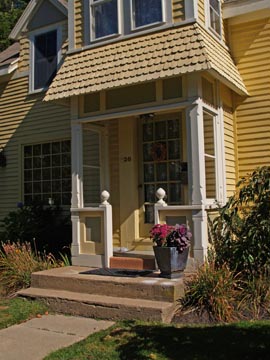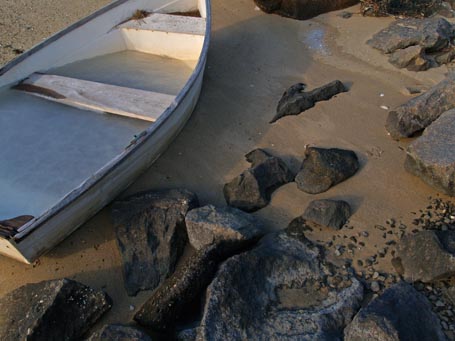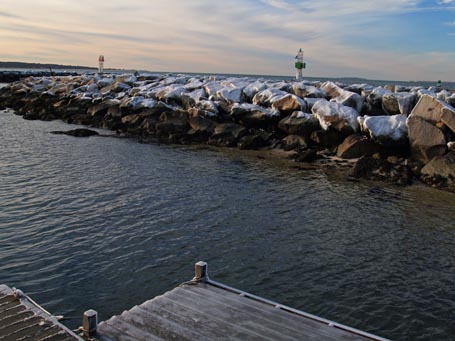
Entries from January 1, 2010 - January 31, 2010
A Modern Farmhouse in Vermont
 Photos (and drawings) provided by Susan and Ryan Hayes.A couple builds a smaller, affordable, “green” house
Photos (and drawings) provided by Susan and Ryan Hayes.A couple builds a smaller, affordable, “green” house
When I called Susan Hayes to talk to her about her new, affordable, “green” house in Williston, Vermont, one of the first things she said was, “We really wanted to respect the local vernacular…” She and her husband Ryan created what they call a “Modern Farmhouse”. The exterior was inspired by the farmhouse Ryan’s dairy-farming great grandparents’ owned, and “the inside is really sparse which is more of a Modern feel,” explains Susan. Their hybrid aesthetic is unusual for a “green” home. The fact that it’s smaller is a “green” hallmark.
Smaller and greener
I found Susan and Ryan through their blog Building Green in Vermont in which they've documented their home’s “green” evolution.  “We really weren’t that enlightened when we started,” admits Susan. But thanks, in part, to a lengthy local permitting process, they had time to research and educate themselves in efficient and sustainable design. Susan discovered that “size is absolutely critical.” After estimates for an initial design proved too expensive, she and Ryan realized they would need to downsize to keep the construction of their first house on budget and “green”. They scrapped plans for a 2200 sq. ft house (not including a finished, walk-out basement) for a 1568 sq. ft house (not including a finished, walk-out basement).
“We really weren’t that enlightened when we started,” admits Susan. But thanks, in part, to a lengthy local permitting process, they had time to research and educate themselves in efficient and sustainable design. Susan discovered that “size is absolutely critical.” After estimates for an initial design proved too expensive, she and Ryan realized they would need to downsize to keep the construction of their first house on budget and “green”. They scrapped plans for a 2200 sq. ft house (not including a finished, walk-out basement) for a 1568 sq. ft house (not including a finished, walk-out basement).
Design Snapshot: Another sweet entry porch
 You might classify this entry as an “integral” porch. Unlike some porches which are applied to a home as a separate entity, this entry porch is integral to the house since there's living space above it.
You might classify this entry as an “integral” porch. Unlike some porches which are applied to a home as a separate entity, this entry porch is integral to the house since there's living space above it.
As part of a two-story bay of sorts, it projects toward the street and takes advantage of the space above it to give it greater prominence. The scalloped shingle skirt, below the sills of the second-floor bay windows, helps announce the entry with a flair of flare. The windows in the entry sidewall contribute a playful indoor/outdoor feel to this semi-enclosed entry porch. Paneled half walls appear poised to embrace guests. Chamfered post and panel details are enhanced by a dynamic paint-color scheme. Together, the quirky elements of this diminutive entry suggest a storybook cheerfulness.
by Katie Hutchison for the House Enthusiast
Design snapshot: Siting inspiration
 Click on this photo to see it in the KHS photo note cards/prints gallery.I imagine most folks associate Martha's Vineyard with summer. Not me. It’s a favorite winter place. It’s quiet then, rugged and achingly beautiful. When I came upon this frozen dinghy, cozying up to some rocks in Lobsterville, I was reminded why I’m so taken with the Vineyard this time of year.
Click on this photo to see it in the KHS photo note cards/prints gallery.I imagine most folks associate Martha's Vineyard with summer. Not me. It’s a favorite winter place. It’s quiet then, rugged and achingly beautiful. When I came upon this frozen dinghy, cozying up to some rocks in Lobsterville, I was reminded why I’m so taken with the Vineyard this time of year.
Brimming with ice, the boat was parked almost as firmly on the beach as the dark, worn rocks it had chosen for company. Frozen water had found level in the old beached vessel. A pattern of lapping waves in the sand swirled around the boat’s bowed sides and neighboring rounded rocks. By contrast, the square edges of the boat’s seats betrayed our often orthogonal constructs. The combination of curves, both natural and man-made, and straight or level surfaces, both natural and man-made, transfixed me.
When I look at this photo today, it seems a model of sympathetic site design. I will tuck it away in my visual memory to tap into when pondering how to create a future site design in which a human intervention resonates with its natural environment.
by Katie Hutchison for the House Enthusiast
The happiness of place
 Click on this photo to see it in the KHS photo note cards/prints gallery.Last week, parked on Martha’s Vineyard in Menemsha facing the harbor on a grey, cold day, I was in a happy place. My husband was interviewing some local fishermen in a nearby boat for a story he’s writing. I was bundled in a down coat and polar-fleece hat, absorbing the waning heat from the car ride up Island. I had a new novel to entertain me, which I’d bought the day before at the 50%-off end-of-season sale at Edgartown Books. It was a pretty entertaining and somewhat ribald read (This Is Where I Leave You by Jonathan Tropper) about a dysfunctional, East-Coast family of adults sitting shiva for the family patriarch, an atheist.
Click on this photo to see it in the KHS photo note cards/prints gallery.Last week, parked on Martha’s Vineyard in Menemsha facing the harbor on a grey, cold day, I was in a happy place. My husband was interviewing some local fishermen in a nearby boat for a story he’s writing. I was bundled in a down coat and polar-fleece hat, absorbing the waning heat from the car ride up Island. I had a new novel to entertain me, which I’d bought the day before at the 50%-off end-of-season sale at Edgartown Books. It was a pretty entertaining and somewhat ribald read (This Is Where I Leave You by Jonathan Tropper) about a dysfunctional, East-Coast family of adults sitting shiva for the family patriarch, an atheist.
In between pages, I looked through the windshield at the battered fishing boat strapped to the dock below and the group of men huddled inside the wheel house. I could see my husband’s wool-capped head bent over his reporter’s note pad. A glance to my right revealed more of the nearly empty parking lot, wind-blown beach and frozen breakwater beyond. Then back to my book. This was cozy bliss.
We all know of places we associate with happiness. It might be your childhood home, your kitchen, a garden, a town square, even a market. I could make a long list. I imagine sometimes we’re projecting what we feel on these places, and other times these places are projecting themselves on our feelings. If we could decipher the specific qualities of the places which make us happy, then, surely, we could create places with incorporate those characteristics in order to foster our happiness. This is, in part, the subject of Alain de Botton’s The Architecture of Happiness which I reviewed here.
When I apply my understanding of architectural space to my experience parked in Menemsha, I realize part of what appealed to me was my ability to experience a larger space or vista from within the comfort of a bordering, more intimate space.















